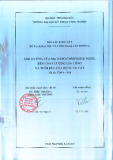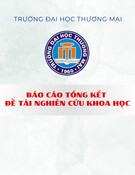
Project Name
Code: 2.13
Development of an Improved Capability for the Control
of Classical Swine Fever on Large and Small Pig Farms
Australian Personnel Dr Harvey Westbury
Australian Institution CSIR0 Livestock Industries
Australian Animal Health Laboratory
Vietnam Institute NaVetCo
Project Duration July 2001 to June 2003
Project Description
The project is to transfer a small suite of laboratory technologies to develop a capability
in Vietnam for the diagnosis and control of the major disease of pigs, causing financial
loss to both large and small scale farmers. The project inputs do not finish at that point,
but further include the provision of training to ensure that the benefits to be derived from
the enhanced technological capability will be available to farmers. Hence the project
spans a number of activities from the laboratory to the farm
Objectives
a) To enhance cell culture capability at NAVETCO
b) Transfer CSF diagnostic capability from AAHL to NAVETCO, including cell culture
based techniques of virus isolation and serum neutralisation tests (NPLA) for the
detection of antibody, as well as immunoassay techniques such as antigen and antibody
detection ELISA. Transfer ELISA technology from NAVETCO to DAH laboratories
as requested by DAH.
c) Using cell culture at NAVETCO, make a collection of isolates of CSF viruses from
cases of CSF disease on farms. At NAVETCO and AAHL use molecular techniques to
assess strain variation. Select a subset of isolates for further study.
d) Refurbish facilities for animal experimentation at NAVETCO if necessary. Develop
a standardised challenge model for experimental production of CSF in pigs. Test the
subset of isolates of virulence and test the efficacy of the NAVETCO CSF vaccine in
protecting against challenge.
e) Train NAVETCO and DAH staff in outbreak investigation for the investigation of
cases of CSF on farms, including sampling strategies and data collection. Develop a
register of apparent and proven cases of vaccine failure, and develop strategies to
analyse causes.
f) NAVETCO will use the new cell culture capability to produce an experimental cell
culture based on CSF vaccine, with the new objective of replacing existing products
and procedures for their use under both large and small scale farming conditions.
g) Develop pig health care information and training packages for large and small scale
pig farmers and their veterinary advisors, with emphasis on CSF prevention and
prevention of other infectious diseases.

Outputs and Performance indicators
Outputs
Performance Indicators
♦ Establish an enhanced cell culture capability in
the NAVETCO laboratories.
Output: Cell cultures for virus propagation,
isolation from field samples and for serology by
NPLA
i) Cell cultures in large and small
flasks and in microtitre plates
routinely available, without bacterial
or fungal contamination.
♦ Transfer CSF diagnostic capability from AAHL
to NAVETCO, including cell culture based
techniques of virus isolation and serum
neutralisation tests (NPLA) for the detection of
antibody, as well as immunoassay techniques
such as antigen and antibody detection.
ELISA. Transfer ELISA technology from
NAVETCO to DAH laboratories as requested
by DAH.
Outputs: Functional tests as described, at
NAVETCO and the DAH lab in Ho Chi Minh City.
i) Results; internal quality control
sheets for examination, correct
results ion external profeiciency
tecting organised by AAHL, CSF
virus isolates
♦ Using cell culture at NAVETCO, make a
collection of isolates of CSF viruses from cases
of CSF disease on farms. At NAVETCO and
AAHL use molecular techniques to assess
strain variation. Select a subset of isolates for
further study.
Outputs: A panel of CSF virus isolates, and a
subset for further study
i) A register of field samples at
NAVETCO CSF virus isolates, viral
RNA submitted to AAHL, molecular
analyses available, a subset of
isolates nominated.
♦ Refurbish facilities for animal experimentation
at NAVETCO if necessary. Develop a
standardised challenge model for experimental
production of CSF in pigs. Test the subset of
isolates for virulence, and test the efficacy of
the NAVETCO CSF vaccine in protecting
against challenge.
Outputs: CSF virus isolates tested for virulence,
efficacy of current vaccine against strains of virus
in the subset tested, a challenge model available for
future work.
i) Experimental records of the
experimental infections, a protocol
for the challenge model recorded,
including details of virus strain,
dose, merthod of application,
clinical observations and end points
for animal use.

♦ Train NAVETCO and DAH staff in outbreak
investigation for the investigation of cases of
CSF on farms, including sampling strategies
and data collection. Develop a register of
apparent and proven cases of vaccine failure.
ii) Instruction notes developed by the
project for reference of investigation
teams, records of farms investigated
by NAVETCO of DAH, a register of
field samples received at
NAVETCO, a published analysis of
information from a number of farms,
extension advice (advice sheets for
large and small scale farmers?) on
CSF vaccine use.
♦ NAVETCO will use the new cell culture
capability to produce an experimental cell
culture based CSF vaccine, with the objective
of replacing existing products. The challenge
model developed above will be used in efficacy
studies.
Outputs: A cell culture derived CSF vaccine that
is effective and cheap to produce.
iii) Laboratory records on selection of a
strain, seed lotting, innocuity testing,
animal testing.
♦ Train NAVETCO in conduct of field trials of
CSF vaccines, to identify appropriate products
and procedures for their use on both large and
small scale farms.
Outputs: Instruction notes developed by thte
project on procedures for vaccine field testing, data
on the effectiveness and recommended use of
existing product, and any newly developed product.
iv) Instruction notes available,
NAVETCO staff trained, records of
on-farm studies available, product
information sheets amended if
necessary.
♦ Develop pig health care information and
training packages for large and small scale pig
farmers and their veterinary advisors, with
emphasis on CSF prevention and prevention of
other infectious diseases.
Outputs: A pig health care information and
training packages for large and small scale pig
farmers and their veterinary advisors.
v) Records of consultation with focus
or study groups of large and small
scale pig farmers and/or their
veterinary advisors as to appropriate
methods, design document(s) for a
pilot study(s), written
recommendations,

COMPLETION REPORT
Executive Summary
The project achieved its major objectives; the transfer and of Classical Swine Fever
(CSF) diagnostic technologies to the National Vetinarnary Company (NAVETCO)
and ELISA technologies to the Department of Animal Health (DAH), a preliminary
survey of the effectiveness of CSF vaccines used around Ho Chi Minh City (HCMC)
and training in disease investigation and control. NAVETCO scientists received
training at AAHL and NAVETCO in ELISA technologies, molecular techniques,
histology and immunohistochemistry, tissue culture techniques, including those for
virus isolation and serology and laboratory quality assurance. DAH scientists
received training in ELISA technologies and an introduction to cell culture and
molecular techniques. CSF diagnostics have been established at NAVETCO,
including an enhanced cell culture capability. CSFV ELISA technology was
transferred to the DAH Laboratory from NAVETCO, further training is
recommended to establish these techniques and CSF diagnostics at DAH. A
workshop on CSF diagnostics, disease investigation, post mortem techniques, sample
collection, farm biosecurity, CSFV vaccines and control of CSF was ran by AAHL
and NAVETCO, at NAVETCO, and was used to provide information and training in
pig health with emphasis on CSF prevention and prevention of other infectious
diseases. Twenty-two participants took part in the workshop with a further 30
veterinarians and senior DAH officials attending the final day of the work shop for
discussions on the control of CSFV.
The data produced in the project has shown the CSF vaccines are not effective in the
control of CSFV in farms around HCMC. DAH and NAVETCO has data that shows
farms can achieve good antibody levels on farms from vaccination if the correct CSF
vaccine and vaccination protocol are used. This information was made possible by CSF
diagnostics
AAHL the lead Australia organisation managed project, providing necessary equipment,
reagents and laboratory ware and training required to allow the completion of the project
and outcomes listed above. AAHL kept the project on target and has supported all
requests from the Vietnamese partners. Training was carried out in Australia and
Vietnam with both partners benefiting from the information that is being generated.
Implementation of the project in Vietnam by NAVETCO, the lead Vietnamese
organisation, was managed well. Trainees were supplied in a timely manner, from
NAVETCO and DAH. NAVETCO and DAH supplied equipment and upgrades to their
laboratories to take full advantage of the new technologies. The field work was organised
well, with data being collected from farms using different vaccines and vaccine protocols,
highlighting the issues with the CSFV vaccines.

1. Project Description
1.1 Background and preparation
CSF is a disease of major concern in Vietnam causing large losses to pig farmers, both
commercial and smallholder. Vietnam produces a vaccine for CSF at NAVETCO, but
there are concerns regarding its effectiveness. NAVETCO had been assigned by MARD
to study CSF (also known as hog cholera) to improve national diagnostic capability and
to develop a vaccine based on cell culture techniques. CSF is known internationally as
one of the most serious diseases of pigs. Depending on the strain of virus, infection may
result in mortalities of up to 100%. In countries where the virus has not been eradicated,
the disease is controlled by vaccination. The economic cost of CSF to Vietnam would be
difficult to quantitate without an accurate diagnostic capability, but the assessment by
DAH and MARD that it is the most serious problem facing the pig industry can be
accepted.
Improved control of CSF will deliver financial benefits directly to both large and small
farmers, and be economically beneficial to the country. Project inputs will be mainly in
the area of animal health, improving veterinary science capability and taking the work the
extra step to ensure that the benefits of the increased capability can be utilized. The
project will result in a lasting increase in the capability of NAVETCO for research and
development in vaccine development, testing, field evaluation and use. The importance of
assisting farmers to derive benefit from the product will be emphasized.
1.2 Context and rationale
AAHL is Australia’s national laboratory for the diagnosis of animal diseases exotic to
Australia. It is involved in the development, management and application of tests for a
large range of animal disease agents using a variety of traditional and advanced
technologies. It is frequently involved in collaborative projects in Southeast Asian
countries where expertise on disease diagnosis and related veterinary matters is needed.
AAHL has developed CSF tests for the detection of both CSF virus and antibodies to the
virus, and maintains a cell culture laboratory as well as expertise in the molecular
analysis of virus isolates. AAHL is active in the area of developing and testing vaccines
for CSF.
AAHL had recently completed a major project for ACIAR, on duck virus enteritis (DVE
or duck plague). ACIAR project reviews indicated it was considered a very successful
project. New diagnostic tests for DVE were developed and transferred to NAVETCO,
extensive training for Vietnamese veterinarians was delivered and a new vaccine was
developed and evaluated.
The National Veterinary Company (NAVETCO) is an agency within the Ministry of
Agriculture and Rural Development of Viet Nam. NAVETCO produces vaccines for
many animal and poultry diseases and has a Research section which studies disease,
introduces new diagnostic techniques and develops new vaccines. The research section is
also involved in training scientists from other institutes and students from universities.
A close relationship has developed between AAHL and NAVETCO due to the successful
project in DVE, which helped produce a new DVE vaccine which is cheaper to produce
















![Báo cáo seminar chuyên ngành Công nghệ hóa học và thực phẩm [Mới nhất]](https://cdn.tailieu.vn/images/document/thumbnail/2025/20250711/hienkelvinzoi@gmail.com/135x160/47051752458701.jpg)









